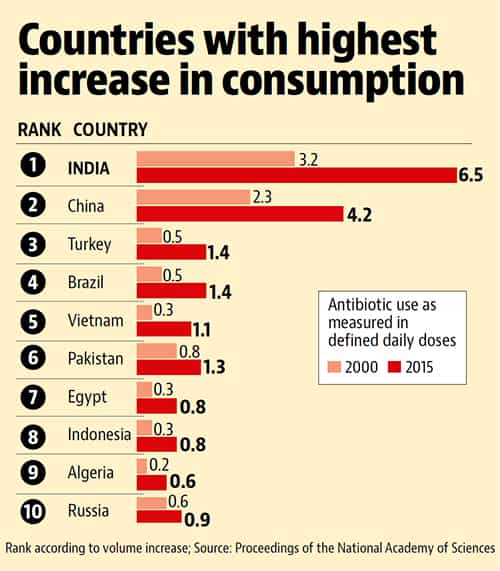India’s antibiotic use doubles in 15 years, common infections harder to treat: Study
Rising incomes, over-the-counter sale, a poorly regulated private hospital sector, high rates of hospital infection, inexpensive antibiotics and frequent infectious disease outbreaks are driving consumption in India and other low- and middle-income countries.
Antibiotic use more than doubled in India between 2000 and 2015, fuelling antibiotic resistance that is making common infections such as E.coli, strep throat, pneumonia and tuberculosis more difficult to treat, according to a new study in the Proceedings of the National Academy of Sciences (PNAS).

Antibiotic use in India went up from 3.2 billion defined daily doses (DDD) to 6.5 billion in 2015, the study said, reflecting increasing economic growth and more access to antibiotics in both the public and private sectors.
In 2015, the total global antibiotic consumption was 35 billion DDDs, a 65% increase from 2000, shows the analysis of antibiotic use in 76 countries.
Misuse and overuse of antibiotics have made once easily treatable bacterial infections harder and often impossible to cure because bacteria evolve rapidly to evade antibiotics, leading to drug resistance, the study added.

Rising incomes, over-the-counter sale, a poorly regulated private hospital sector, high rates of hospital infection, inexpensive antibiotics and frequent infectious disease outbreaks are driving consumption in India and other low- and middle-income countries. “The background burden of bacterial infections, and misuse for all fevers regardless of whether they are caused by parasites, viruses or bacteria, is another major causal factor. Unless we improve regulation, we can expect that the resistance problem will get worse,” said study co-author Dr Ramanan Laxinarayan, director of the Center for Disease Dynamics, Economics & Policy (CDDEP). Antibiotics are only effective against bacterial infections.
Two decades ago, scientists tackled drug resistance with new and more powerful antibiotics and drug combinations. But with the last new class of antibiotics (versus variations and improvements on existing ones) discovered in 1987 — a few new ones in development are not ready for market — the world is running out of options.
Worryingly, use of third-generation antibiotics such as cepahlosporins and linezolids used to treat mutlidrug-resistant bacteria have increased dramatically in India since 2000, reports the study, done by CDDEP, Princeton University, ETH Zurich and the University of Antwerp.
Data from the Indian Council of Medical Research (ICMR) antimicrobial resistance (AMR) surveillance network shows similar trends. “From data obtained so far, more than 70% Enterobacteriaceae — which include Salmonella, E. coli, Yersinia pestis, Klebsiella, and Shigella — are resistant to third-generation cephalosporins. Among the Enterobacteriaceae species, Klebsiella and E. coli have been found to be resistant to third-generation cephalosporins (80%),” said Dr Kamini Walia, senior scientist and programme officer (AMR) at ICMR.
Cephalosporins belong to a class of antibiotics called fluoroquinolones that can be administered orally. When resistance to these drugs increases, patients have to stay in hospital longer for antibiotics to be given intravenously or intramuscularly, which pushes up cost and puts them at risk of other hospital infections.
“Linezolid is one of the newest classes of antibiotics available to us and the loss of this drug will be a problem for [treating] enterococci and Staph aureus, both of which are a big problem in the Indian healthcare system,” said Dr Laxminarayan, whose study is the most comprehensive assessment of global trends to date.
“India needs to remove irrational fixed dose combinations, educate physicians on appropriate antibiotic prescribing, regulate over-the-counter sale of newer antibiotics and increase vaccination coverage,” said Laxminarayan.
Twenty-four potent antibiotics are included in India’s Schedule H1 of the Drugs & Cosmetic Rules that makes it mandatory for the medicines to have red-line labelling and for the pharmacist to keep a separate register with the name and address of the prescriber, patient’s name, the name of the drug and the quantity supplied.
“We need tighter regulation to ensure these rules are implemented to stop over-the-counter sale and irrational prescriptions. After oral Cephalosporins became available in India — it was administered intravenously earlier — resistance shot up to 70%,” said Dr Walia.
Catch your daily dose of Fashion, Taylor Swift, Health, Festivals, Travel, Relationship, Recipe and all the other Latest Lifestyle News on Hindustan Times Website and APPs.
Catch your daily dose of Fashion, Taylor Swift, Health, Festivals, Travel, Relationship, Recipe and all the other Latest Lifestyle News on Hindustan Times Website and APPs.






